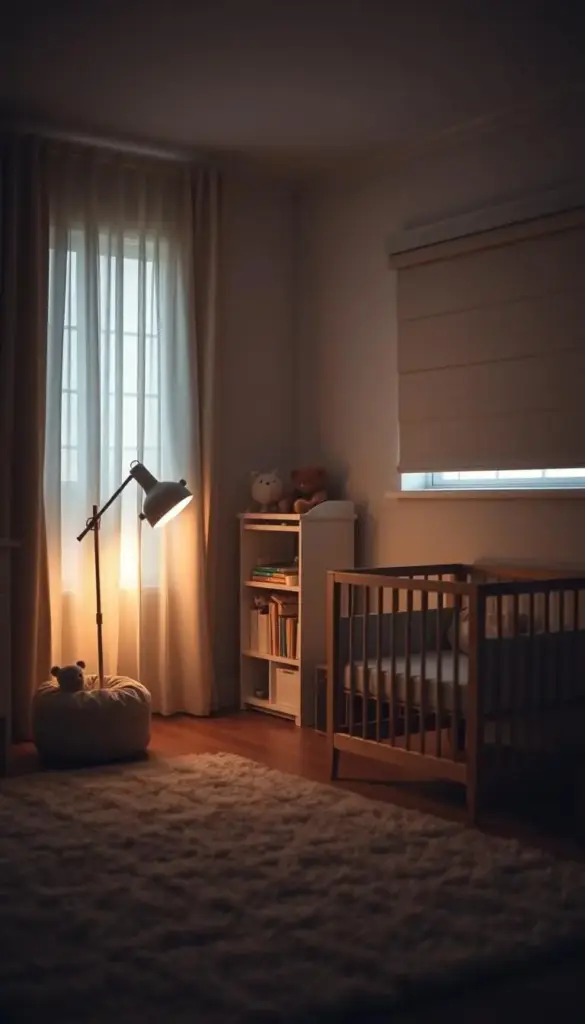Did you know many toddlers have trouble sleeping? This can affect their mood and growth. As a parent, you’re not alone in this fight. Remember, every child is unique.

Starting a bedtime routine is important, whether you’re new or have tried before. A good sleep environment and healthy sleep habits can help a lot. We’ll share useful sleep training tips for different parenting styles and toddler personalities.
Key Takeaways
- Establish a consistent bedtime routine for your toddler.
- Create a sleep-friendly environment to promote better sleep.
- Understand and respond to your toddler’s unique needs.
- Be patient and flexible; what works for one child may not work for another.
- Develop a pre-sleep routine that signals bedtime to your toddler.
Understanding Toddler Sleep Patterns and Needs
Figuring out your toddler’s sleep needs can change your family’s life. As your child grows from 1 to 3 years old, their sleep changes a lot. Knowing these changes helps you set up a good sleep routine.
Normal Sleep Requirements by Age
Toddlers need a lot of sleep for growing up. A toddler between 1 and 3 years old needs about 12 to 14 hours of sleep. This includes both nighttime sleep and daytime naps.
| Age | Total Sleep Needed | Nighttime Sleep | Daytime Sleep |
|---|---|---|---|
| 1-2 years | 12-14 hours | 9-11 hours | 2-3 hours |
| 2-3 years | 11-13 hours | 10-12 hours | 1-2 hours |
Sleep Cycles and How They Differ from Adults
Toddlers’ sleep cycles are shorter than adults’. While adults have 90-minute cycles, toddlers have 50-60 minute cycles. This makes it harder for them to settle down or stay asleep.
Signs Your Toddler is Ready for Sleep
Knowing when your toddler is ready for sleep helps set up a bedtime routine. Look for signs like yawning, rubbing their eyes, or becoming less active. Some toddlers may also become more clingy or irritable when tired.
- Yawning or rubbing eyes
- Becoming less active or quieter
- Clinginess or irritability
By understanding your toddler’s sleep patterns and needs, you can find a sleep training strategy that works for your child and family.
Why Sleep Training Matters for Toddlers and Parents
Sleep training is more than just getting your toddler to sleep. It’s about making your family’s life better. By setting a regular sleep routine, you help your toddler sleep well. This also makes life better for everyone in your family.
Cognitive and Physical Development Benefits
Good sleep is key for your toddler’s brain and body. Sleep helps their brain remember things and their body grow. Sleep training makes sure your toddler gets enough sleep for:
- Learning new things and remembering them
- Handling their feelings and acting right
- Growing strong and healthy
Studies show that well-rested toddlers do better in school and get along better with others. By focusing on sleep training, you’re giving your child a great start in life.
Impact on Family Dynamics and Parental Well-being
Sleep training helps not just your toddler but also your family and you. When your toddler sleeps all night, you feel less stressed and anxious. This leads to:
| Benefit | Description |
|---|---|
| Reduced Stress | Less worry about bedtime and nighttime wake-ups |
| Improved Relationships | Stronger bonds with your toddler and with each other |
| Increased Energy | More energy to play and enjoy time together |
By setting a regular sleep routine, you’re not just helping your toddler sleep better. You’re also making your family’s life more peaceful and fun.
Essential Sleep Training Tips Every Toddler Parent Should Know
Setting a consistent sleep routine for your toddler can change your family’s life. A well-rested toddler is happier, healthier, and more likely to behave well. Here, we’ll share key tips for toddler sleep training.
Consistency: The Foundation of Successful Sleep Training
Consistency is key in toddler sleep training. A predictable bedtime routine helps your toddler know what to expect. This routine can include bath time, reading, singing, or storytelling. It’s important to be consistent and make sure all caregivers agree.
- Develop a calming and predictable bedtime routine.
- Stick to the routine, even on weekends or during vacations.
- Ensure all caregivers are aware of and follow the routine.
Setting Age-Appropriate Sleep Expectations
It’s vital to set sleep expectations that match your toddler’s age. Knowing the normal sleep needs for your child’s age helps set realistic goals. Toddlers between 1-3 years old need 12-14 hours of sleep in a 24-hour period, including naps.
Here are some general guidelines for sleep expectations by age:
| Age | Total Sleep Needed | Naps |
|---|---|---|
| 1-2 years | 12-14 hours | 1-2 naps |
| 2-3 years | 10-13 hours | 1 nap |
Maintaining Patience Through the Process
Sleep training can be tough, and toddlers might resist changes. It’s important to stay patient and understanding. Remember, it’s okay if your toddler doesn’t adjust right away. Consistency and patience will lead to successful sleep training.
To stay patient, consider these tips:
- Stay calm and composed, even when your toddler is fussy.
- Keep the long-term goals in mind and celebrate small successes.
- Take care of yourself; a well-rested parent is better equipped to handle sleep training challenges.
By following these essential tips, you can help your toddler develop healthy sleep habits. Remember, every child is different, so be ready to adjust your approach as needed.
Creating the Perfect Toddler Sleep Environment
To help your toddler sleep better, make their sleep area the best it can be. A good sleep space helps them fall asleep and stay asleep. This leads to better rest and health.
Optimizing Room Temperature, Lighting, and Comfort
Keeping the room at a comfy temperature is key. Aim for 68-72 degrees Fahrenheit. This keeps them from getting too hot or cold, helping them sleep better.
Also, make sure the room is dark. Darkness helps their body know it’s time to sleep. This is important for both nighttime and naps.
Comfort is also essential. Use a soft mattress and simple, cozy bedding. This makes their bed inviting.

Managing Noise and Distractions
Keeping noise levels down is vital for a good sleep space. A sound machine with white, pink, or brown noise can help. These sounds block out other noises that might wake them up. Just make sure the volume isn’t too loud.
Also, keep the room free of distractions. No toys or objects near the bed that could keep them awake.
Selecting Appropriate Comfort Items and Sleep Associations
Comfort items can make your toddler feel safe and calm. Choose safe items like soft toys or blankets. It’s also important to have a consistent sleep routine.
This routine can be something like a special toy or a certain activity. It tells your toddler it’s time to sleep. By picking the right items and routines, you help them sleep well for years to come.
Establishing an Effective Toddler Bedtime Routine
Creating a calming pre-sleep routine can help your toddler sleep better. A consistent bedtime routine tells your toddler it’s time to relax and sleep.
Essential Components of a Calming Routine
A good bedtime routine includes activities that calm and delight your toddler. Think about:
- A warm bath to relax their muscles
- A gentle massage or reading a bedtime story
- Singing a lullaby or playing soothing music
- Dimming the lights to signal the approaching night
These activities make a peaceful space for your toddler to get ready for sleep.
Timing Your Routine for Maximum Effectiveness
When you start your bedtime routine is very important. Start it 20-30 minutes before bedtime. This lets your toddler slowly wind down.
Be flexible and adjust the timing as needed. This depends on your child’s responses and needs.
Ensuring Consistency Between All Caregivers
Consistency is key in a bedtime routine. Make sure all caregivers follow the same routine. This helps your toddler understand and stick to their sleep schedule.
Talk to all caregivers about the routine and why it’s important. A consistent and calming bedtime routine helps your toddler sleep well and benefits your whole family.
Popular Toddler Sleep Training Methods and Techniques
Many parents struggle to get their toddlers to sleep well. Luckily, there are several sleep training methods to choose from. It’s important to pick one that fits your parenting style and your child’s needs. Each family is different, and knowing the options can help you decide.

Gradual Withdrawal and Fading Methods
The gradual withdrawal method helps your toddler learn to fall asleep alone. Start by sitting next to their bed and then move further away. Fading methods also help, by slowly reducing how much you do for your child at bedtime.
The Chair Method for Anxious Toddlers
The chair method is great for anxious toddlers. It means sitting in a chair next to their bed until they fall asleep. Then, you move the chair further away, helping your child get used to sleeping without you.
Bedtime Fading for Night Owls
Bedtime fading is good for toddlers who don’t want to go to bed. It means starting bedtime a little later each night until they fall asleep easily. Once they’re sleeping well, you can move bedtime back to an earlier time.
Positive Reinforcement and Reward Systems
Positive reinforcement is a strong tool in sleep training. Praise your child for their efforts and progress. A reward system, like stickers for dry nights, can also help. Choose rewards that your child likes and change them as needed.
By using these sleep training methods, you can help your child sleep better. Remember, being consistent and patient is key to success.
Navigating Common Toddler Sleep Problems
Dealing with toddler sleep issues needs patience, consistency, and knowledge. Many toddlers face sleep problems that upset the whole family. You’re not alone in this challenge.
Addressing Bedtime Resistance and Stalling Tactics
Bedtime resistance is when toddlers stall or refuse to sleep. A consistent bedtime routine helps signal it’s time for bed. This can include a warm bath, reading, or singing.
To tackle bedtime resistance:
- Stick to your routine every day, even on weekends or vacations.
- Stay away from screens and exciting activities before bed.
- Make the sleep area dark, quiet, and cool.
Solving Night Wakings and Early Morning Rising
Night wakings and early rising are common sleep issues. It’s key to know why they happen. Causes can be hunger, discomfort, nightmares, or night terrors.
| Issue | Possible Cause | Solution |
|---|---|---|
| Night Wakings | Hunger, discomfort, or nightmares | Ensure the room is comfortable, and consider a bedtime snack if hunger is an issue. |
| Early Morning Rising | Too much daytime sleep, or an inconsistent wake time | Adjust nap times, and establish a consistent morning wake time. |
Helping Toddlers Through Nightmares and Night Terrors
Nightmares and night terrors are scary for toddlers and hard for parents. Nightmares happen during REM sleep and can be remembered. Night terrors occur during deep sleep and are not recalled.
To comfort your child during nightmares:
- Be there and reassuring.
- Avoid talking about the nightmare before bed.
- Have a calming pre-sleep routine.
Successful Crib-to-Bed Transitions
Switching from a crib to a bed is a big step. Let your child help pick out the new bed or bedding.
For a smooth transition:
- Keep the bedtime routine the same.
- Make sure the new bed is comfy and safe.
- Be ready for nighttime wanderings.
Understanding and solving these sleep problems helps your child sleep well. Every child is different, so be patient and adjust your approach as needed.
Managing Toddler Sleep Regressions
Toddlers often go through sleep regressions, making parents tired and frustrated. These regressions can be caused by many things. Knowing what they are can help you deal with this tough time.
Common Triggers: Development, Illness, and Life Changes
Toddlers grow and develop a lot, which can mess with their sleep. Things like teething, learning new skills, or changes in their environment can cause sleep problems. Also, getting sick or going through big changes, like moving or getting a new sibling, can affect their sleep too.
Knowing what causes sleep regressions can help you fix the problem. For example, if your toddler is teething, giving them pain relief can help them sleep better at night.
Recognizing the Signs of Sleep Regression
How do you know if your toddler is having a sleep regression? Look for signs like waking up a lot at night, not wanting to go to bed, or having trouble falling asleep. They might also become more clingy or demanding during the day.
If you see these signs a lot, your toddler is probably going through a sleep regression. It’s important to stay calm and patient. Getting angry can make things worse.
Strategies to Overcome Regression and Restore Sleep
There are ways to help your toddler get past sleep regression. First, keep their bedtime routine the same. A consistent routine can make your toddler feel safe and help them sleep better.
- Stick to the established bedtime routine.
- Give your toddler a comforting object, like a soft toy or blanket, to feel secure.
- Try to keep their environment the same to avoid stress.
- Be patient and let your toddler adjust at their own pace.
By knowing what causes sleep regressions, recognizing the signs, and using these strategies, you can help your toddler get through sleep regressions. This can also improve their sleep habits over time.
Conclusion: Building Healthy Sleep Habits for Life
You’ve started helping your toddler develop good sleep habits for life. By using the key sleep training tips, you’ve set your family up for better rest.
Being consistent and patient is very important. Celebrate every small success. And don’t get too upset when things don’t go as planned. It’s all part of the journey. With time and effort, your toddler will learn to sleep well for years to come.
Keep in mind that sleep training tips don’t work the same for everyone. Be open to changing your approach to meet your child’s needs. This way, you’ll give your toddler a good night’s sleep and get a break too.






